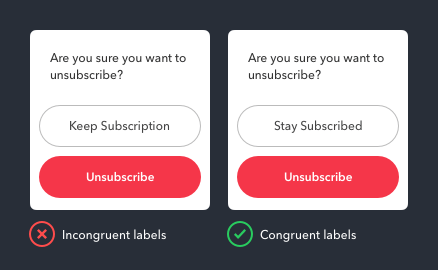What Is UX Writing?
UX writing involves writing interactive copy that guides the user experience. This includes small but important bits of text that are referred to collectively as microcopy—everything from menu and navigational labels to notifications, buttons, and CTAs. UX writing also includes longer-form copy like product-generated emails and instructional text that is part of a flow or an experience.
While UX writing has a strong focus on microcopy, there’s a lot more to it than just creating cute error messages. A UX writer’s primary job is to guide the user through a task with clear, readable text that’s mindful of their emotional state—for example, jokey or lighthearted copy shouldn’t appear during a sensitive financial task flow.
Because UX writing is so intimately connected with the UX design process, the term “content design” is often used to refer to it along with the activities that support it. For example, performing user research, creating voice and tone guidelines, and defining task flows. The reality is that UX writers do a lot more than just write. In fact, in many organizations, their efforts contribute to an overall UX content strategy.
UX writing is also sometimes known as “product writing,” particularly when it involves writing UX copy within an application or software product. But it isn’t limited to product—UX writers have to consider the user experience when writing copy for websites and marketing emails.
Qualities of Good UX Writing
Effective UX writing is:
- Clear. Good writing should clearly guide the user to the next step, leaving them with no doubt about what comes next in the task flow. Copy should never prioritize cleverness at the expense of clarity.
- Concise. Users want to complete their tasks quickly, without reading unnecessary text. UX copy that’s succinct helps them do that—and it’s also easier to read.
- Accessible. UX copy needs to work well with screen readers and other accessibility tools. (Accessibility Checker is one such tool.)
- Brand-appropriate. Every interaction a user has with your website or product is part of an ongoing conversation with your brand. Good UX writing leverages that conversation by ensuring copy is consistent with the brand voice.
- Context-appropriate. Effective copy accommodates the user’s frame of mind. Ignoring context can lead to a poor user experience.
To provide contrast, here is an example of poor writing, courtesy of UX Movement:

Why It Matters for B2B Marketing
B2Bs know that a positive user experience leads to better business results. Customers come to a website to complete certain tasks, such as finding information or filling out an application. Good UX copy guides them through that process, helping them successfully complete their task. Conversely, a poor user experience will drive users away, never to return.
In addition, UX writing (and UX design as a whole) aims to create a positive experience for your customers, leading to greater brand loyalty. Guiding the customer to the desired information or task is especially important in a B2B context, where complex information is conveyed over a longer buying process. With its unique ability to guide and reassure the customer, UX writing is a powerful tool for increasing conversions.
Need Help Optimizing Your UX?
Count on Tendo’s combined expertise in content strategy and user experience to help you design and develop intuitive websites and apps that solve your customers’ problems—as we have for some of the world’s best-known B2B brands. Let us know what your needs and goals are. Contact us today.

